[English] 日本語
 Yorodumi
Yorodumi- PDB-8yf8: Cryo-EM structure of Dragon Grouper nervous necrosis virus-like p... -
+ Open data
Open data
- Basic information
Basic information
| Entry | Database: PDB / ID: 8yf8 | |||||||||
|---|---|---|---|---|---|---|---|---|---|---|
| Title | Cryo-EM structure of Dragon Grouper nervous necrosis virus-like particle at pH5.0 (3.52A) | |||||||||
 Components Components | Capsid protein alpha | |||||||||
 Keywords Keywords | VIRUS / nervous necrosis virus / Dragon Grouper / Cryo-EM structure | |||||||||
| Function / homology | Nodavirus capsid / nodavirus capsid protein / Viral coat protein subunit / viral capsid / Capsid protein alpha Function and homology information Function and homology information | |||||||||
| Biological species |  Dragon grouper nervous necrosis virus Dragon grouper nervous necrosis virus | |||||||||
| Method | ELECTRON MICROSCOPY / single particle reconstruction / cryo EM / Resolution: 3.52 Å | |||||||||
 Authors Authors | Wang, C.H. / Chang, W.H. | |||||||||
| Funding support |  Taiwan, 2items Taiwan, 2items
| |||||||||
 Citation Citation |  Journal: ACS Infect Dis / Year: 2024 Journal: ACS Infect Dis / Year: 2024Title: Molecular Mechanism of pH-Induced Protrusion Configuration Switching in Piscine Betanodavirus Implies a Novel Antiviral Strategy. Authors: Petra Štěrbová / Chun-Hsiung Wang / Kathleen J D Carillo / Yuan-Chao Lou / Takayuki Kato / Keiichi Namba / Der-Lii M Tzou / Wei-Hau Chang /   Abstract: Many viruses contain surface spikes or protrusions that are essential for virus entry. These surface structures can thereby be targeted by antiviral drugs to treat viral infections. Nervous necrosis ...Many viruses contain surface spikes or protrusions that are essential for virus entry. These surface structures can thereby be targeted by antiviral drugs to treat viral infections. Nervous necrosis virus (NNV), a simple nonenveloped virus in the genus of betanodavirus, infects fish and damages aquaculture worldwide. NNV has 60 conspicuous surface protrusions, each comprising three protrusion domains (P-domain) of its capsid protein. NNV uses protrusions to bind to common receptors of sialic acids on the host cell surface to initiate its entry via the endocytic pathway. However, structural alterations of NNV in response to acidic conditions encountered during this pathway remain unknown, while detailed interactions of protrusions with receptors are unclear. Here, we used cryo-EM to discover that Grouper NNV protrusions undergo low-pH-induced compaction and resting. NMR and molecular dynamics (MD) simulations were employed to probe the atomic details. A solution structure of the P-domain at pH 7.0 revealed a long flexible loop (amino acids 311-330) and a pocket outlined by this loop. Molecular docking analysis showed that the N-terminal moiety of sialic acid inserted into this pocket to interact with conserved residues inside. MD simulations demonstrated that part of this loop converted to a β-strand under acidic conditions, allowing for P-domain trimerization and compaction. Additionally, a low-pH-favored conformation is attained for the linker connecting the P-domain to the NNV shell, conferring resting protrusions. Our findings uncover novel pH-dependent conformational switching mechanisms underlying NNV protrusion dynamics potentially utilized for facilitating NNV entry, providing new structural insights into complex NNV-host interactions with the identification of putative druggable hotspots on the protrusion. | |||||||||
| History |
|
- Structure visualization
Structure visualization
| Structure viewer | Molecule:  Molmil Molmil Jmol/JSmol Jmol/JSmol |
|---|
- Downloads & links
Downloads & links
- Download
Download
| PDBx/mmCIF format |  8yf8.cif.gz 8yf8.cif.gz | 159.5 KB | Display |  PDBx/mmCIF format PDBx/mmCIF format |
|---|---|---|---|---|
| PDB format |  pdb8yf8.ent.gz pdb8yf8.ent.gz | 126.9 KB | Display |  PDB format PDB format |
| PDBx/mmJSON format |  8yf8.json.gz 8yf8.json.gz | Tree view |  PDBx/mmJSON format PDBx/mmJSON format | |
| Others |  Other downloads Other downloads |
-Validation report
| Summary document |  8yf8_validation.pdf.gz 8yf8_validation.pdf.gz | 1.3 MB | Display |  wwPDB validaton report wwPDB validaton report |
|---|---|---|---|---|
| Full document |  8yf8_full_validation.pdf.gz 8yf8_full_validation.pdf.gz | 1.4 MB | Display | |
| Data in XML |  8yf8_validation.xml.gz 8yf8_validation.xml.gz | 48.2 KB | Display | |
| Data in CIF |  8yf8_validation.cif.gz 8yf8_validation.cif.gz | 69.1 KB | Display | |
| Arichive directory |  https://data.pdbj.org/pub/pdb/validation_reports/yf/8yf8 https://data.pdbj.org/pub/pdb/validation_reports/yf/8yf8 ftp://data.pdbj.org/pub/pdb/validation_reports/yf/8yf8 ftp://data.pdbj.org/pub/pdb/validation_reports/yf/8yf8 | HTTPS FTP |
-Related structure data
| Related structure data |  39214MC  8xidC 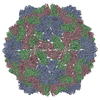 8yf6C 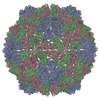 8yf7C 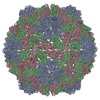 8yf9C M: map data used to model this data C: citing same article ( |
|---|---|
| Similar structure data | Similarity search - Function & homology  F&H Search F&H Search |
- Links
Links
- Assembly
Assembly
| Deposited unit | 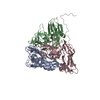
|
|---|---|
| 1 | x 60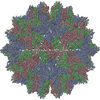
|
| 2 |
|
| 3 | x 5
|
| 4 | x 6
|
| 5 |
|
| Symmetry | Point symmetry: (Schoenflies symbol: I (icosahedral)) |
- Components
Components
| #1: Protein | Mass: 37128.754 Da / Num. of mol.: 3 Source method: isolated from a genetically manipulated source Source: (gene. exp.)  Dragon grouper nervous necrosis virus / Production host: Dragon grouper nervous necrosis virus / Production host:  #2: Chemical | Has ligand of interest | Y | |
|---|
-Experimental details
-Experiment
| Experiment | Method: ELECTRON MICROSCOPY |
|---|---|
| EM experiment | Aggregation state: PARTICLE / 3D reconstruction method: single particle reconstruction |
- Sample preparation
Sample preparation
| Component | Name: Dragon Grouper nervous necrosis virus-like particle at pH5.0 (180 subunits) Type: COMPLEX / Entity ID: #1 / Source: RECOMBINANT |
|---|---|
| Source (natural) | Organism:  Dragon grouper nervous necrosis virus Dragon grouper nervous necrosis virus |
| Source (recombinant) | Organism:  |
| Buffer solution | pH: 5 |
| Specimen | Embedding applied: NO / Shadowing applied: NO / Staining applied: NO / Vitrification applied: YES |
| Vitrification | Cryogen name: ETHANE |
- Electron microscopy imaging
Electron microscopy imaging
| Microscopy | Model: JEOL 2100F |
|---|---|
| Electron gun | Electron source:  FIELD EMISSION GUN / Accelerating voltage: 200 kV / Illumination mode: FLOOD BEAM FIELD EMISSION GUN / Accelerating voltage: 200 kV / Illumination mode: FLOOD BEAM |
| Electron lens | Mode: BRIGHT FIELD / Nominal defocus max: 2930 nm / Nominal defocus min: 870 nm |
| Image recording | Electron dose: 30 e/Å2 / Film or detector model: DIRECT ELECTRON DE-20 (5k x 3k) |
- Processing
Processing
| CTF correction | Type: PHASE FLIPPING AND AMPLITUDE CORRECTION |
|---|---|
| 3D reconstruction | Resolution: 3.52 Å / Resolution method: FSC 0.143 CUT-OFF / Num. of particles: 22364 / Symmetry type: POINT |
 Movie
Movie Controller
Controller






 PDBj
PDBj

